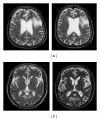Bilateral transplantation of allogenic adult human bone marrow-derived mesenchymal stem cells into the subventricular zone of Parkinson's disease: a pilot clinical study
- PMID: 22550521
- PMCID: PMC3328274
- DOI: 10.1155/2012/931902
Bilateral transplantation of allogenic adult human bone marrow-derived mesenchymal stem cells into the subventricular zone of Parkinson's disease: a pilot clinical study
Abstract
The progress of PD and its related disorders cannot be prevented with the medications available. In this study, we recruited 8 PD and 4 PD plus patients between 5 to 15 years after diagnosis. All patients received BM-MSCs bilaterally into the SVZ and were followed up for 12 months. PD patients after therapy reported a mean improvement of 17.92% during "on" and 31.21% during "off" period on the UPDRS scoring system. None of the patients increased their medication during the follow-up period. Subjectively, the patients reported clarity in speech, reduction in tremors, rigidity, and freezing attacks. The results correlated with the duration of the disease. Those patients transplanted in the early stages of the disease (less than 5 years) showed more improvement and no further disease progression than the later stages (11-15 years). However, the PD plus patients did not show any change in their clinical status after stem cell transplantation. This study demonstrates the safety of adult allogenic human BM-MSCs transplanted into the SVZ of the brain and its efficacy in early-stage PD patients.
Figures





References
-
- Parkinson J. An essay on the shaking palsy. The Journal of Neuropsychiatry and Clinical Neurosciences. 2002;14(2):223–222. - PubMed
-
- Moore DJ, West AB, Dawson VL, Dawson TM. Molecular pathophysiology of Parkinson’s disease. Annual Review of Neuroscience. 2005;28:57–87. - PubMed
-
- von Bohlen und Halbach UHO, Schober A, Krieglstein K. Genes, proteins, and neurotoxins involved in Parkinson’s disease. Progress in Neurobiology. 2004;73(3):151–177. - PubMed
-
- Adler CH. Nonmotor complications in Parkinson’s disease. Movement Disorders. 2005;20(supplement 11):S23–S29. - PubMed
-
- Braak H, Ghebremedhin E, Rüb U, Bratzke H, Del Tredici K. Stages in the development of Parkinson’s disease-related pathology. Cell and Tissue Research. 2004;318(1):121–134. - PubMed
LinkOut - more resources
Full Text Sources

